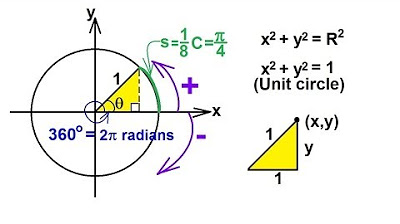Belajar Matematika Dengan Mudah - Perbandingan Trigonometri Dalam Segitiga Siku-siku.
Summary
TLDRThis video tutorial covers the fundamentals of trigonometry, focusing on the conversion of angles between degrees and radians. It demonstrates the process of converting from degrees to radians using formulas and vice versa. The lesson also explores trigonometric ratios (sine, cosine, and tangent) within right-angled triangles and their corresponding formulas. Various examples are provided to illustrate the concepts, and tips for memorizing key trigonometric relationships are offered. The video concludes by applying the learned principles to solve practical trigonometric problems, ensuring a clear understanding of angle measures and trigonometric functions.
Takeaways
- 😀 The script introduces the concept of converting angles between degrees and radians, explaining the formulas and providing examples for both conversions.
- 😀 To convert degrees to radians, multiply by π/180, and to convert radians to degrees, multiply by 180/π.
- 😀 The first example explains how to convert 30° to radians, resulting in π/6, and 90° to radians, resulting in π/2.
- 😀 In the second part, the script demonstrates converting radians to degrees, using examples of 1/4π radians (which equals 45°) and 2/3π radians (which equals 120°).
- 😀 The script discusses trigonometric ratios in right-angled triangles, including sine, cosine, and tangent, which depend on the sides of the triangle.
- 😀 The sine of an angle is the ratio of the opposite side to the hypotenuse, the cosine is the ratio of the adjacent side to the hypotenuse, and the tangent is the ratio of the opposite side to the adjacent side.
- 😀 In a right triangle, if angle A is being considered, the opposite side is BC, the adjacent side is AC, and the hypotenuse is AB.
- 😀 The script provides simplified formulas to remember trigonometric ratios: sin = y / R, cos = x / R, and tan = y / x, where y is the opposite side, x is the adjacent side, and R is the hypotenuse.
- 😀 Example problems are presented, such as calculating the sine, cosine, and tangent of an angle in a right triangle with sides of 3 cm, 4 cm, and 5 cm.
- 😀 The script also touches on reciprocal trigonometric functions: cosecant (csc), secant (sec), and cotangent (cot), explaining that they are the inverses of sine, cosine, and tangent respectively.
Q & A
What is the main topic of the lecture presented in the script?
-The main topic of the lecture is trigonometry, specifically focusing on the conversion between degree and radian measurements, as well as the trigonometric ratios in right-angled triangles.
How do you convert degrees to radians, as mentioned in the script?
-To convert degrees to radians, you multiply the degree value by π/180. For example, 30° is converted to radians by multiplying 30 by π/180, resulting in π/6 radians.
What is the formula for converting radians to degrees?
-To convert radians to degrees, you multiply the radian value by 180/π. For example, 1/4π radians is converted to degrees by multiplying by 180/π, which gives 45°.
What are the main trigonometric ratios introduced in the script?
-The main trigonometric ratios discussed are sine (sin), cosine (cos), tangent (tan), secant (sec), cosecant (csc), and cotangent (cot).
How do you calculate the sine of an angle in a right-angled triangle?
-The sine of an angle in a right-angled triangle is calculated by dividing the length of the side opposite the angle by the length of the hypotenuse. For example, sin(α) = BC/AB, where BC is the opposite side and AB is the hypotenuse.
What is the formula for calculating the cosine of an angle in a right-angled triangle?
-The cosine of an angle is calculated by dividing the length of the adjacent side by the length of the hypotenuse. For example, cos(α) = AC/AB, where AC is the adjacent side and AB is the hypotenuse.
How do you calculate the tangent of an angle in a right-angled triangle?
-The tangent of an angle is calculated by dividing the length of the opposite side by the length of the adjacent side. For example, tan(α) = BC/AC.
What are the reciprocal functions of sine, cosine, and tangent?
-The reciprocal functions of sine, cosine, and tangent are cosecant (csc), secant (sec), and cotangent (cot), respectively. These can be calculated as follows: csc(α) = 1/sin(α), sec(α) = 1/cos(α), and cot(α) = 1/tan(α).
Can you provide an example of calculating sin(30°) from a right-angled triangle?
-In a right-angled triangle with an angle of 30°, the sine can be calculated by dividing the length of the side opposite the angle (e.g., BC) by the hypotenuse (e.g., AB). For sin(30°), the result is 1/2.
How do you find the value of sin(60°) in a right-angled triangle?
-For sin(60°), the length of the side opposite the angle (e.g., BC) is multiplied by √3, and then divided by the hypotenuse (e.g., AB). The final result is sin(60°) = √3/2.
Outlines

This section is available to paid users only. Please upgrade to access this part.
Upgrade NowMindmap

This section is available to paid users only. Please upgrade to access this part.
Upgrade NowKeywords

This section is available to paid users only. Please upgrade to access this part.
Upgrade NowHighlights

This section is available to paid users only. Please upgrade to access this part.
Upgrade NowTranscripts

This section is available to paid users only. Please upgrade to access this part.
Upgrade NowBrowse More Related Video

Konversi Sudut - Ukuran Derajat - Konversi Radian ke Derajat dan Sebaliknya - Trigonometri Part 3

Trigonometri Matematika Kelas 10 • Part 1: Ukuran Sudut Derajat dan Radian

Angle Measure (Precalculus)

TRIGONOMETRY 1 (PRECALCULUS) (1 of 54) What Is The Unit Circle?

Matematika SMA - Trigonometri (3) -Sistem Kuadran, Relasi Sudut Trigonometri (A)

Perbandingan Trigonometri Pada Segitiga Siku-siku - Matematika Wajib Kelas X
5.0 / 5 (0 votes)